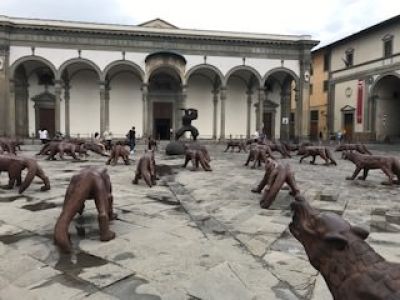Una cosa sorprendente che ha successo quest’estate a Firenze - due branchi di lupi sono arrivati in centro città. Un branco sta davanti al palazzo Pitti e l'altro sta davanti la Chiesa Santissima Annunziata. Molti turisti sono rimasti scioccati quando hanno visto i lupi. Ma questi lupi sono statue, il lavoro dell’artista cinese Lui Ruowang. I branchi assomigliano molto ai lupi veri e da lontano, sembrano che siano reali. Questi lupi sono un simbolo per il rapporto diplomatico buono fra italia e cina per gli ultimi cinquanta anni. La cosa ironica, dopo l’arrivo del Covid in italia dalla Cina, molte persone pensano che i branchi simbolizzano i tempi caotici e stressati e un rapporto differente fra le due nazioni. Le statue rimangono a Firenze fino al 26 ottobre.
Visitors to Florence this summer may be very surprised to come across two packs of wolves in the heart of the city, one outside the Pitti Palace and the other in the piazza in front of the Santissima Annunziata Church and the Spedale degli Innocenti.
There are 100 life-size iron casts, each weighing over 600 pounds. From a distance they look realistic, but on closer acquaintance, they are obviously an art installation on a grand scale. They are the work of Chinese artist Liu Ruowang and are intended to be an allegory of nature’s response to the ravages and predatory behavior of mankind towards the environment. At the same time, on a more immediate level, they are fun and quite a surprise. Children cannot resist snarling at them or climbing on their backs, not at all put off by their fierce expressions. The “pop up” playground will no doubt be missed when they are removed at the end of October.
The project was conceived to celebrate 50 years of diplomatic relations between Italy and the People’s Republic of China, organized by a collaboration between the Uffizi Galleries, the municipality of Florence and the Lorenzelli Arte Gallery, Milan.
There is a certain irony in celebrating such diplomatic relations, however. After the cover-up of the initial outbreak of COVID-19 in Wuhan, China then engaged in ‘wolf warrior diplomacy’ (so called after the ‘Wolf Warrior’ Chinese propaganda action films). Indeed, the installation’s publicity suggests that the work reflects today’s uncertain times, especially with the dramatic effects of COVID-19 and a world apparently destined for self-destruction. Maybe the packs of wolves carry a hidden message, more political than environmental.
The 100 Wolves Installation remains in situ until Oct. 26, 2020.



